

| Cryptocephalus querceti at Sherwood Forest NNR |
| Rearing Cryptocephalus querceti in captivity |
| ...... |
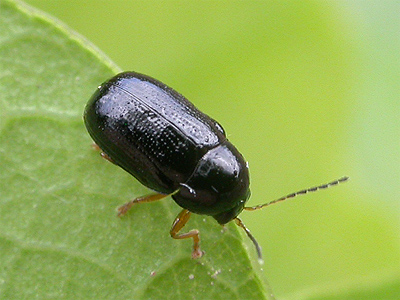 |
Well
known for its wide range of saproxylic beetles, Sherwood
Forest is also home to two very rare Cryptocephalus
leaf beetles. The most well known and studied of these
beetles at Sherwood is Cryptocephalus coryli
(RDB1), which was found after a lengthy 70 year break in
the records back in 2008. In late May 2011, we finally made a real effort to try and track down the much smaller Cryptocephalus querceti (RDB2), a beetle known for its preference of feeding on the epicormic growth, very characteristic of many of Sherwood Forest's ancient and mature Oaks. This page will be added to a various times, as further information becomes available through study and survey. |
| ...... | ||
| Recent records of C.
querceti from Sherwood Forest and
the UK We had made several casual efforts to find Nottinghamshire's one remaining Cryptocephalus beetle that had eluded us since 2009, but had failed to find any in brief searches within the confines of the Sherwood Forest Country Park. Making a real go of it this time and by using the interactive maps provided on the NBN website, we were able to narrow down our search to relatively few old Oaks in two of the areas where C. querceti had previously been recorded. Nationally, Cryptocephalus querceti is known from just a handful of sites in the UK, from Sherwood Forest, Windsor Great Park and Donnington Park. There are also records from Chat Moss (Lancashire) and Langford Moor in Nottinghamshire. Sherwood Forest has very few records for querceti, but it was found during surveys in 1998 (Lott, D.) and then more recently in 2010 (Alexander, K.) On the other hand, a targeted survey to find the beetle in 1999 provided completely negative results. One of the querceti habitat problems Sherwood Forest has had for many decades is the amount of Bracken. This has been mentioned as a possible reason why querceti has never been found in the numbers here, as it has at Windsor Great Park. |
||
| ...... | ||
| Recent
work to restore much of the Country Park area to wood
pasture, may eventually prove to be helpful in making the
whole site more suitable to querceti and it may
become increasingly easier to find as time goes on.
Whether the lack of large areas of grass pasture and
suitable leaf litter substrate underneath Sherwood's
ancient Oaks is responsible or not, it does not appear to
have stopped the beetle from holding on in certain
ungrazed areas, although we have not yet been able to
devote more time in our search to try and provide more a
accurate picture of querceti's range across
suitable areas within the NNR. With no more infomation for us to go on apart from "showing a preference for the epicormic growth on mature Oak trees" we checked virtually all the Oaks in two compartments at Clipstone Old Quarter, finding querceti in just one of the two compartments and then on only a few mature and one semi-mature trees. Saying that, we chose to devote most of our searching time, to those Oaks growing in more sheltered locations out of the wind, but we did make searches of scrub Oaks growing in both the surveyed compartments. |
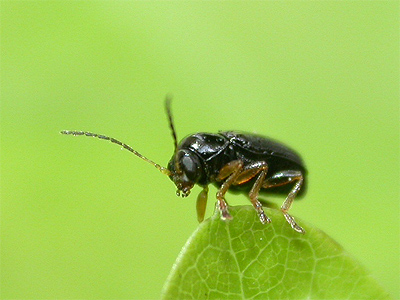 |
|
| ...... | ||
| Records of Cryptocephalus
querceti from Sherwood Forest NNR
in 2011 Finding C. querceti actually proved to be quite easy, when compared to some species we have deliberately looked for here. Despite the very windy and eventually wet conditions on the morning of May 28th 2011, it took just over an hour of visual searching to be successful. Visual searching of suitable sites (although not quick) is the best method of finding most of the Cryptocephalus species we have looked for and the technique employed to find querceti, was to stand underneath the lower branches of an ancient Oak and look up to search for the beetle in silhouette on the leaf against the sunlight, or heavy rain in this instance. The big advantage of visual searching over beating, is that you are not disturbing hundreds of invertebrates just to find one. |
||
| ...... |
| Date | Observer/recorder | Sex | Location on tree/vegetation | Under-storey flora/habitat | Situation | |||||
| .. | ||||||||||
| 29/05/2023 | .. | Pendleton, T.A. Brownley, N. and Brownley, S. | .. | Female | .. | On epicormic growth (3 feet) of ancient Oak | .. | Bracken/leaf litter | .. | Haloed (3yr) |
| .. | .. | Pendleton, T.A. Brownley, N. and Brownley, S. | .. | Female | .. | On epicormic growth (4 feet) of ancient Oak | .. | Bracken/leaf litter | .. | Haloed (3yr) |
| .. | .. | Pendleton, T.A. Brownley, N. and Brownley, S. | .. | Female | .. | On epicormic growth (4 feet) of ancient Oak | .. | Bracken/leaf litter | .. | Haloed (3yr) |
| .. | .. | Pendleton, T.A. Brownley, N. and Brownley, S. | .. | Male | .. | On epicormic growth (12 feet) of ancient Oak | .. | Bracken/leaf litter | .. | Haloed (3yr) |
| .. | .. | Pendleton, T.A. Brownley, N. and Brownley, S. | .. | Male | .. | On epicormic growth (11 feet) of ancient Oak | .. | Bracken/leaf litter | .. | Haloed (3yr) |
| 26/05/2023 | .. | Pendleton, T.A. | .. | Female | .. | On epicormic growth (8 feet) of ancient Oak | .. | Bracken/leaf litter | .. | Haloed (3yr) |
| 25/05/2023 | .. | Pendleton, T.A. | .. | Female | .. | On lower branches (8 feet) of ancient Oak | .. | Bracken/leaf litter | .. | Haloed (2yr) |
| .. | .. | Pendleton, T.A. | .. | Female | .. | On lower branches (8 feet) of ancient Oak | .. | Bracken/leaf litter | .. | Haloed (2yr) |
| 28/05/2011 | .. | Pendleton, T.A. and D.T. | .. | Male | .. | On lower branches (6 feet) of ancient Oak | .. | Grass and Bracken/leaf litter | .. | Open |
| .. | .. | Pendleton, T.A. and D.T. | .. | Male | .. | On lower branches (7 feet) of semi-mature Oak | .. | Bracken/leaf litter | .. | Open |
| .. | .. | Pendleton, T.A. and D.T. | .. | Female | .. | On lower branches (5 feet) of ancient Oak | .. | Grass and Bracken/leaf litter | .. | Sheltered |
| .. | .. | Pendleton, T.A. and D.T. | .. | Female | .. | On lower branches (5 feet) of ancient Oak | .. | Grass and Bracken/leaf litter | .. | Sheltered |
| .. | .. | Pendleton, T.A. and D.T. | .. | Female | .. | On lower branches (5 feet) of ancient Oak | .. | Grass and Bracken/leaf litter | .. | Sheltered |
| 29/05/2011 | .. | Pendleton, T.A. and D.T. | .. | Female | .. | On lower branches (6 feet) of ancient Oak | .. | Grass and Bracken/leaf litter | .. | Sheltered |
| 02/06/2011 | .. | Pendleton, T.A. and D.T. | .. | Male | .. | On lower branches (8 feet) of ancient Oak | .. | Grass and Bracken/leaf litter | .. | Sheltered |
| .. | .. | Pendleton, T.A. and D.T. | .. | Female | .. | On lower branches (6 feet) of ancient Oak | .. | Grass and Bracken/leaf litter | .. | Sheltered |
| The above table gives the details for each individual Cryptocephalus querceti recorded since 2011. Those found on May 29th 2023, were all recorded from the same Oak, as were the two querceti found on May 25th 2023. | ||
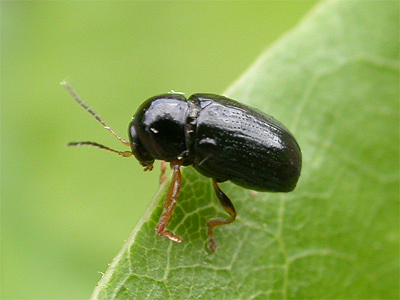 |
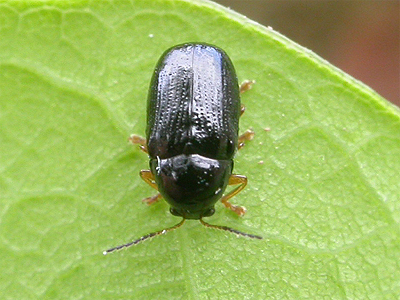 |
|
| ...... | ||
| Although
conditions were not exactly ideal for trying to locate a
2.5 - 3.5mm black beetle, with a fondness for ancient
Oaks. Searching for C. querceti was made
slightly more difficult with the presence of Cryptocephalus
labiatus in the same area. Although we have found C.
labiatus at several Nottinghamshire sites now, we
had not recorded it from this area of Sherwood Forest
before, and it is certainly not a common species here, so
we were pleased to have at least found labiatus,
even if we failed in our search for querceti. In
the end, we need not have worried. After locating a
possible male found resting underneath a leaf along the
mid-rib, continuing heavy rain meant the search had to be
abandoned until better weather came during the afternoon.
On return home, the beetle was indeed confirmed as a male
C. querceti. In the field, this beetle showed immediate differences to a male labiatus, even to the unaided eye. There was an appreciable difference in size based on our own experiences of male labiatus, and querceti appeared slightly longer, less dumpy looking and also slightly longer-legged. |
||
| ...... | ||
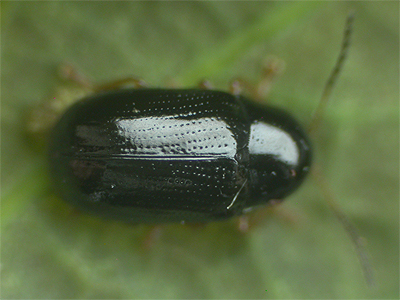 |
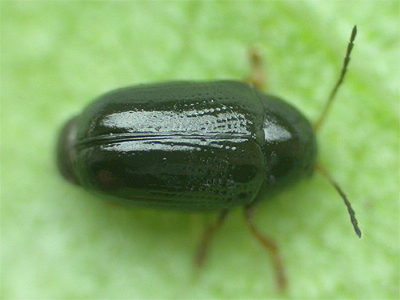 |
|
| ...... | ||
| A hand lens
also showed that the elytral punctures on querceti
were noticeably finer than on labiatus. The
differences in the elytral puncturation between female Cryptocephalus
querceti and Cryptocephalus labiatus, are
clearly shown in the above photographs, with querceti
on the left showing the much finer punctures of the two
species. Leg colour was a slightly more difficult matter
that gave us cause for concern and additional confusion
was added by repeated internet-based references to querceti
having completely yellow legs, when in truth there is
usually a dark patch on the rear femora of querceti.
We subsequently recorded another male and three females on our return visit to Clipstone Old Quarter later that same afternoon and it is interesting to note that two of the three females were found on the same branch of one particular Oak, growing in probably the most sheltered location in the compartment. An additional female was found on the same branch the next day (May 29th) and both male and female were later found on June 2nd. |
||
| ...... | ||
| Cryptocephalus
querceti habitat at Clipstone Old
Quarter To find a total of six adults on a weekend when the weather conditions were relatively poor, was especially pleasing. Although at this still very early stage in our recording and study of C.querceti, we feel it important that some mention of the immediate habitat is made. The two common factors to the locations in which querceti were recorded, were that they were all found on low branches with a generally south-facing aspect and on trees that had some grass growing underneath the outer branches. No adults were found on true, young epicormic growth on the trunks, but new off shoots on low branches did produce records. The following four photographs show the habitat and locations of the six adult Cryptocephalus querceti recorded. These photographs are taken within one of the two compartments we were able to search on May 28th and 29th 2011, in which adults were found. The upper left photograph, shows the ancient Oak on which we found the first male. This was on the lowest branch visible, bottom right of the tree. A surprising second record came from the semi-mature Oak in the upper right photograph. |
||
| ...... | ||
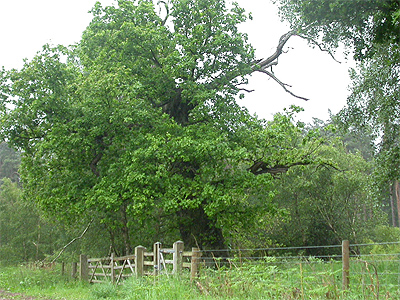 |
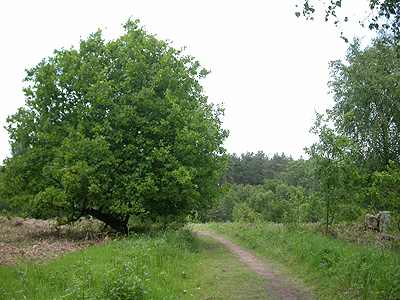 |
|
| ...... | ||
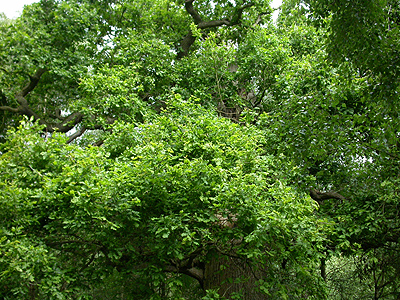 |
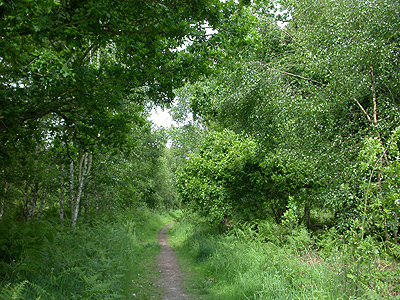 |
|
| ...... | ||
| The lower two photographs show another tree from different angles. This was the most sheltered location on site and responsible for producing all three females found over the two day period, all three being found on one low branch. Young Birch grow adjacent to this Oak, providing shelter. It is not known if this Oak may become less productive for querceti, if these Birches are removed during haloing around the ancient Oaks. | ||
| ...... | ||
| Cryptocephalus
querceti egg laying and pot
production Identification of the adults we took home was possible from the many photographs we obtained, but we did keep two males and two females for captive breeding purposes, before releasing them back at the site of capture. As with most Cryptocephalus species, pairing occurs very easily and the first pots were produced on May 29th. Female querceti are much more articulate in pot construction than C. coryli, holding the pot in the rear metatarsi and continuously turning the pot with great dexterity during the latter stages of construction. |
||
| ...... | ||
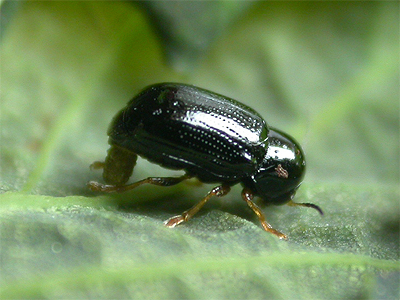 |
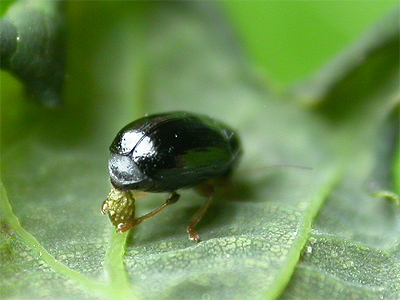 |
|
| ...... | ||
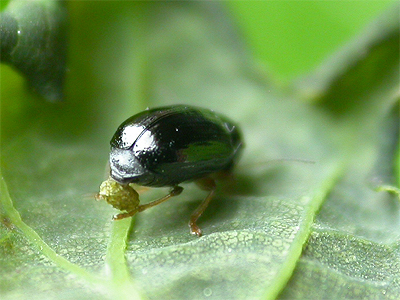 |
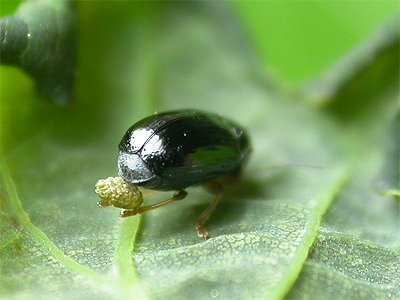 |
|
| The 0.5mm long pot of C. querceti (below left) is very similar to that produced by C. labiatus (below right). The pots of both species' are broadly oval and with the same twisted texture to the surface. But a strange difference between the two species is that the twists produced by querceti females go from left to right, whilst those produced by labiatus females go from right to left. | ||
| ...... | ||
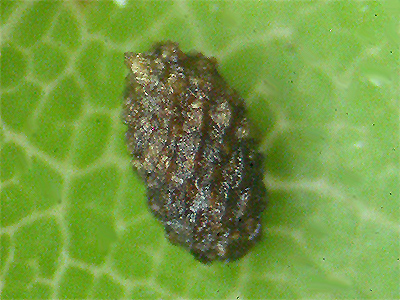 |
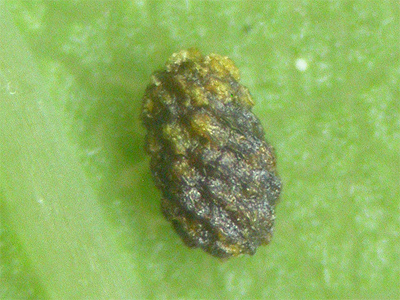 |
|